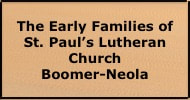bigpigeon.us webpage St. Paul's > Early Families > Early Families Help, updated by RAC 11 Feb 2020.
Each of my 43 St. Paul's Boomer-Neola Early Families reports is a brief biographical sketch of an extended family, members of whom are known to have belonged to St. Paul's over 100 years ago. These reports are not family histories. Rather, they are outlines that a family member might use to help build a family history.
If you have trouble understanding my early families report collection, click on the Family Reports Notes button above. You can notify me of problems through the Contact Form website page.
The following might be helpful when you read these reports.
About the Early Families Index in the St. Paul's Family Reports page:
About the St. Paul's Early Families History and my family history:
About the Early Families Reports Collection:
When listing an individual, I generally identify the generation by a bullet:
Miscellaneous Information:
To those whose family history is outlined herein: In keeping with genealogical protocol, I try to minimize menton of living individuals. If you find data for living family members that you feel does not belong here, please contact me with your concerns and we will work out an accommodation.
About Credits and Resources:
If you have trouble understanding my early families report collection, click on the Family Reports Notes button above. You can notify me of problems through the Contact Form website page.
The following might be helpful when you read these reports.
About the Early Families Index in the St. Paul's Family Reports page:
- The index is in alphabetical order by extended family.
- The index is divided into six parts.
- There is a hotspot under the heads of each of the 43 extended families.
- Clicking on that hotspot opens a PDF file containing my report for that extended family.
- If a family member married into a different early family, the index tells which file to view.
- When done viewing a report, use your browser to return to Big Pigeon.
- The index generally includes only those children and grandchildren who are thought to be early St. Paul’s members. However, the biographical sketch itself usually includes all children and most grandchildren.
- Children are indented and grandchildren are double indented.
- I note instances where the extended family head remained in Denmark.
About the St. Paul's Early Families History and my family history:
- Several families in St. Paul's Early Families History reports are treated in more detail in my family history: Christian Christiansen; Jacob Jensen; Ole Jensen; Lars Christian Rasmussen.
- Portions of the following families in St. Paul's Early Families History reports are treated more fully in my family history: Christian Bondo (Peter Bondo section); Mads Jensen (different sections).
About the Early Families Reports Collection:
When listing an individual, I generally identify the generation by a bullet:
- my great grandparents' generation - large box
- my grandparents' generation - small box
- my parents' generation -circle
- my generation (often omitted) - triangle
- my children's generation (almost always omitted) - very small rectangle
- “RAC” refers to myself, “Robert A. Christiansen”, the author of these sketches.
- “conf.” after birth and death years means the St. Paul’s confirmation year.
- I use the following Danish words:
- “By” means “town”.
- “Sogn” means “parish”. All of Denmark is divided into parishes, each having a Lutheran church. In rural Denmark, a parish usually contains more than one town.
- “Amt” means “county”. I use the 19th century county organization – Denmark no longer has counties.
Miscellaneous Information:
- Danish has a 29-character alphabet. I often use two of the three additional characters in Danish place names. E.g., the "ø" in Praestø and the "æ" in Sjælland.
- I generally use Danish spellings for individuals who left Denmark as adults.
- Unless otherwise noted, the towns and townships mentioned are in Pottawattamie County, Iowa.
- If I haven’t given the occupation of a man living in the St. Paul’s community, assume he was a farmer.
To those whose family history is outlined herein: In keeping with genealogical protocol, I try to minimize menton of living individuals. If you find data for living family members that you feel does not belong here, please contact me with your concerns and we will work out an accommodation.
About Credits and Resources:
- I cite family-specific credits and resources are at the end of a family sketch.
- General credits for organizations and individuals are in the Home > Acknowledgments webpage.
- General sources for web and print resources are listed, with many links, in the Resources webarea.

